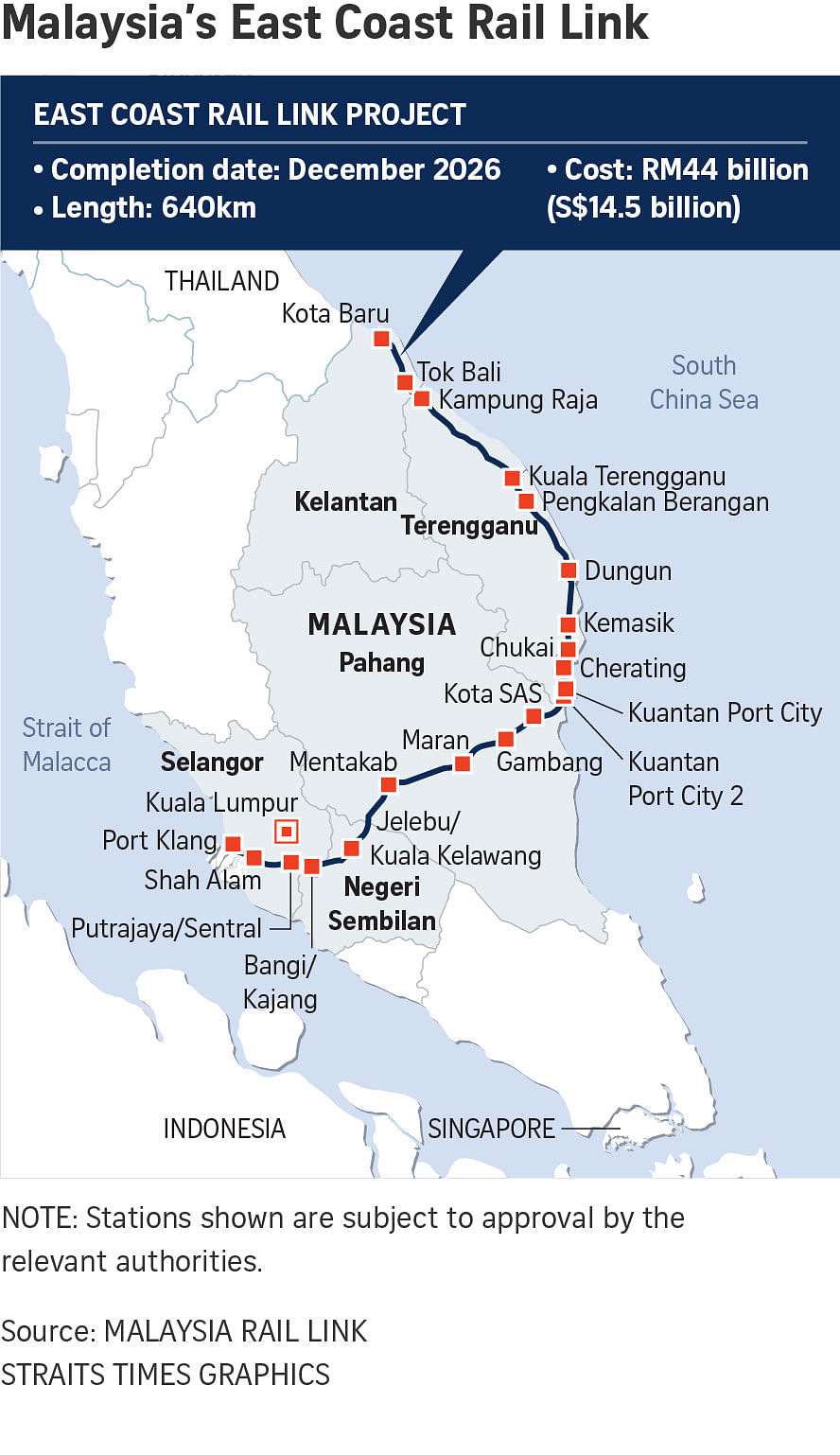Malaysian state okays stalled $12Bn China-backed rail project
Opposition-ruled Selangor agrees to a northern route for East Coast Rail Project, which it had earlier blocked.2021.12.02
AP
A Malaysian state controlled by the opposition has cleared a multibillion-dollar Chinese-backed rail project – the country’s largest – its chief minister announced Thursday about a controversial venture stalled since 2016.
Selangor, which the People’s Justice Party (PKR) rules and is home to Malaysia’s busiest port, has approved the East Coast Rail Link (ECRL) project with the very specifications the party once vehemently opposed.
The rail line, which is part of the Belt and Road Initiative (BRI), China’s global infrastructure-building program, will pass through northern Selangor instead of the southern part of the state like PKR wanted. It will also cost U.S. $12 billion in place of the $10.4 billion the party had negotiated for in 2019.
“I officially announce that the Selangor Government no longer objects to the implementation of the ECRL alignment that traverses the northern part of Selangor,” Amiruddin Shari, Selangor’s chief minister, said.
He said he gave the go-ahead for the rail link to pass through Selangor after being satisfied that the route would be sustainable and economically beneficial to the state’s residents. But one analyst said the project was approved because the current federal government – which first proposed the project – is led by the United Malays National Organization (UMNO).
Amiruddin was speaking at a conference in Kuala Lumpur, which was attended by Transport Minister Wee Ka Siong; Malaysia Rail Link Sdn Bhd, which will oversee the project; and the state-owned China Communications Construction Company, which will build the rail line and the bridge that are part of the ECRL.
25 percent complete
Once built, the project would provide a new rail link between the east and west coasts of Peninsular Malaysia. It would supplant the existing narrow-gauge colonial-era rail network that does not connect directly with Kuala Lumpur.
The project also includes a land bridge for freight transportation from Kuantan Port on the South China Sea to Port Klang, the busiest port located on the Strait of Malacca. The ECRL is scheduled to be completed in 2026, two years after the original finish date.
About 25 percent of the project that passes through three other states has already been completed as of Oct. 31, Transport Minister Wee said at the conference.
The opposition PKR and its Selangor unit had earlier opposed the northern route, saying it was more expensive than the southern one and not as beneficial for the state’s residents.
Under Malaysia’s federalism, matters involving land use are under the authority of state governments, which means the federal ECRL project had been held up because of Selangor.
The 688-km (427-mile) project was launched in August 2017 with a groundbreaking ceremony by then-Prime Minister Najib Razak of UMNO. The ECRL was to – and now will – span the states of Selangor, Pahang, Terengganu and Kelantan.
However, after UMNO suffered a shock defeat in the 2018 national election, the project was shelved, and then revived, but with modifications.
In addition to negotiating a lower price for the rail link, the federal Pakatan government – a coalition headed by PKR – shortened the route to 648 km (402 miles), and set out a new southern route, from Pahang into Negeri Sembilan, and then into southern Selangor.
After the Pakatan government collapsed in March 2020, the successive administration led by Muhyiddin Yassin went back to the ECRL’s original route – announced under Najib – which was protested by the Pakatan-led Selangor state government.
Gesture of gratitude
Amiruddin said he changed his mind about the project after the transport ministry informed him that the northern route was more viable and would provide better economic, environmental, and social benefits when compared with the southern route.
Oh Ei Sun, an expert on Chinese geopolitics, was not surprised the project would now be implemented according to the original plan announced by Najib and UMNO, which is the core party of the Barisan Nasional (BN) coalition.
“Well, we are living under a BN administration right now,” Oh, from the Singapore Institute of International Affairs, told BenarNews, an RFA-affiliated online news service.
He added that currently, there was not much difference between the opposition and BN after they signed a ceasefire agreement following the appointment of Prime Minister Ismail Sabri Yaakob in August.
“There is no genuine and substantive political opposition anymore,” Oh said.
Meanwhile, Transport Minister Wee said that his ministry was looking at the points raised by the Selangor government earlier, about the southern ECRL route. He added that the government was drawing up a long-term plan for a possible new southern rail route in addition to the northern one.
“We are looking into the question of a bypass for Seremban in the area mentioned by [Amiruddin] because we need to continue this interconnectivity [of the rail network],” Wee said.
He added that the government is planning this bypass, as well as a third port in southern Selangor, as a gesture of gratitude to the state government for allowing the original ECRL project to start again.
Malaysian state okays stalled $12Bn China-backed rail project
Opposition-ruled Selangor agrees to a northern route for East Coast Rail Project, which it had earlier blocked.



